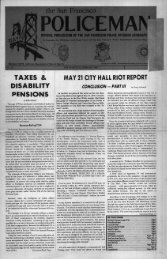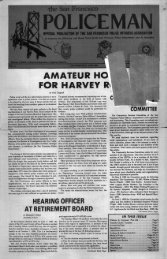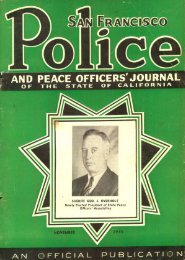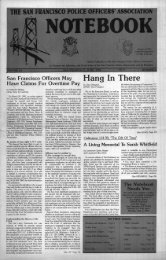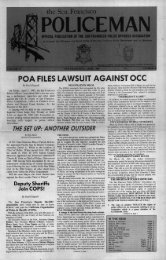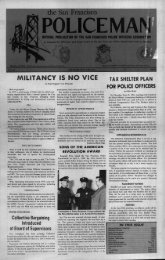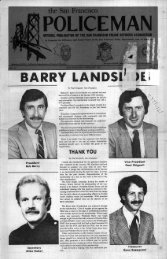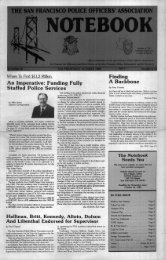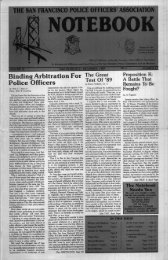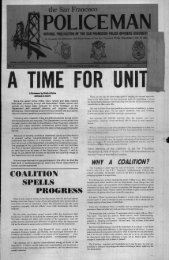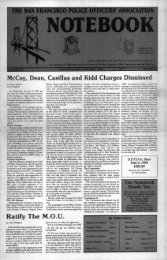August 1988 - San Francisco Police Officers Association
August 1988 - San Francisco Police Officers Association
August 1988 - San Francisco Police Officers Association
You also want an ePaper? Increase the reach of your titles
YUMPU automatically turns print PDFs into web optimized ePapers that Google loves.
<strong>August</strong>, <strong>1988</strong><br />
by Gary Mondfrans, Communications<br />
The other night three major shootings occured, all involving<br />
officers. Near tragedy was averted because the<br />
plc channels were open. It could have been different -<br />
it could have been the next night, for then the PlC channels<br />
were closed for another of those never ending Levelax"<br />
reductions.<br />
The repeated closure of PlC radio channels strikes a<br />
severe blow to officer safety, as it hurts an officer most<br />
when he is most vulnerable - when he is on foot and<br />
out of the car. <strong>Officers</strong> finding themselves in a tight spot<br />
don't have time to fiddle with switching radio channels<br />
to TAC-6 - they need help NOW and call out on<br />
whatever channel their radio is on. Hopefully somebody<br />
will answer - anybody. With constant closure of PlC<br />
channels there is a very real danger that if officers cannot<br />
rely on their radios they will then be forced to rely<br />
on their guns. The Monday morning quarterbacks will say<br />
the officer was wrong. The Monday morning quarterbacks<br />
weren't there - the Monday morning quarterbacks did<br />
not know the fear, either real or perceived, that the officer's<br />
plea for help would not be heard; that the officer<br />
could no longer rely on his radio because someone was<br />
fiddling around with the PICs again!<br />
The present alternative proposal to create just two<br />
"SuperPICS" is not a viable alternative. The resulting congestion<br />
and channel over-loading of nine district stations<br />
plus umpteen numbers of other "uncontrolled" units during<br />
peak periods would be simply horrendous. If a channel<br />
is just too busy, for instance with officers running subjects,<br />
then it might just as well be closed. The only real<br />
alternative is some honest-to-goodness communications<br />
planning, preferably by communications professionals.<br />
Otherwise, the risks are just too great; not only to officersafety,<br />
but to overall efficiency, effective use of limited<br />
resources (i.e., limited numbers of radio channels), manpower<br />
utilization and dispatcher workloads.<br />
The response that there are not enough PlC radio channels<br />
to go around is hogwash when you consider that four<br />
of our present PLC channels are so underused. One PlC<br />
channel, PlC Channel 8, is restricted to just a few "Solos"<br />
In contrast, units in busy districts are clamoring over busy<br />
channels just for a few moments of airtime. The asolo<br />
traffic units could just as easily be accommodated on<br />
TAC-6/CWffl, another of our underused channels, on a<br />
shared basis just as they were in the past. PlC Channel<br />
6 could itself be better used were some thought and planning<br />
used. City Wide-I, (PlC Channel 5 on the new and<br />
modified PICs) is used almost exclusively for the ordering<br />
of tow trucks after about 4:00 p.m. each day, and<br />
even then carries very little radio traffic. With respect to<br />
all other duties an officer performs, the ordering of tows<br />
has got to be about one of the lowest priority functions;<br />
just slightly above the ordering of a taxi cab. To pre-empt<br />
a given channel for such a purpose where such channels<br />
are desperately needed for other purposes is highly questionable.<br />
As an alternative, why can't this channel also<br />
be used for the running of 29/subjects and other computer<br />
queries at night, when a channel for such service<br />
requests is most sorely needed<br />
PLC Channel 9 (CLEMARS-UHF) is almost never used<br />
even though it is available to narcotics/investigative<br />
units on their PICs and is ideally suited to their purposes<br />
in conjunction with PLC Channel 10, which is a simplexdirect<br />
version of Channel 9 on the same frequency, so<br />
that undercover units could easily switch between direct<br />
and repeater operation without missing any of the action.<br />
Use of simplex operation should be encouraged, as it is<br />
not necessary to use a repeater just to talk to other units<br />
just around the corner and because "blabbing" the operation<br />
over a high-powered repeater may tend to compromise<br />
it. Use of PLC Channel 9 by such units would<br />
also free up PLC Channel 7 for other purposes.<br />
It also makes no sense to have a handful of narcotics<br />
enforcement units operating out in the Potrero on a virtually<br />
new and very clear sounding repeater while the remainder<br />
of the units in the Potrero and Mission Districts,<br />
two of the City's busiest and most volatile police districts,<br />
must share the same PLC radio channel which has<br />
historically been plagued by problems and where most<br />
units sound "10-1" irrespective of their location. The PLC-7<br />
repeater system should be re-crystalled a PIC-2 so that<br />
units on Channel 2 could have the benefit of the best<br />
sounding repeater available to them. The old PIC-2<br />
repeater system would then be recrystalled on PLC-7 frequencies<br />
after being serviced and upgraded.<br />
The concept of two "SuperPLCS" was tried for a coupe<br />
of weeks two years ago. The concept failed miserably<br />
- it didn't work then, and it won't work now because<br />
its foundation is fatally flawed. "SuperPICS" can't work<br />
because most run dispatching actually takes place over<br />
the PLC channels. The PICs have long ago ceased being<br />
used just for "service" purposes. What is needed is 3 to<br />
4 PlC dispatch augmented by 1 to 2 PlC service channels<br />
for the running of computer inquiries. All such computer<br />
queries (10-28/29's, etc.) would be run over these<br />
service channels and not on the dispatch channels (except<br />
for taking 585s as traffic stops affect officer/safety),<br />
in order to keep the dispatch PICs from getting cluttered<br />
up with endless 29s. To ease the load, use of MVTs<br />
for the running of 29's would be encouraged, but not required,<br />
as officers would wait to run their subjects over<br />
Notebook<br />
Please Don 't Close The PICs!<br />
the 1 or 2 working "RECORDS/REQUESTS SERVICE<br />
CHANNELS" or do so via their MVTs.<br />
A dedicated channel for the running of subjects does<br />
work across the bay in Oakland. Despite traffic levels approaching<br />
our own, Oakland P.D. does operate on just<br />
two dispatch channels while running all service requests<br />
on a third. That is because the dispatch channels are<br />
limited to essential traffic, as it should be here. Oakland<br />
doesn't even have a radio code equivalent to "10-97"; that<br />
must be done over the mobile terminals. So much money<br />
has been invested in the MVTs that there is no reason<br />
why that should not be required here. Failure to use the<br />
MVT's for simple "10-8" and "10-97' traffic is not only<br />
wasteful but takes away airtime from units with more important<br />
traffic. No matter how many orders are issued,<br />
use of the MVTs will not increase until officers realize that<br />
keeping the channels clear for essential traffic is in their<br />
own best interest.<br />
Even with all the computer hardware we load into patrol<br />
vehicles there is no substitute for a decent, reliable 2-way<br />
radio system. It should be obvious to all why the PLC<br />
system should be improved: that is simply the fact that<br />
more units are available via PlC radio than they are by<br />
Low Band. Try it yourself, Headquarters. Call a unit<br />
simultaneously on LB and PLC: I bet 9 times out of 10<br />
that the unit will answer over PLC. Even when a unit is<br />
supposedly "10-8," more than 60-70% of the time he will<br />
answer on PLC and the reasons for this are quite<br />
understandable:<br />
1) More than 99% of the time officers have access to<br />
their PLC portable radios.<br />
2) In contrast, units have access to Low Band radios<br />
only when they are in their vehicles or when they<br />
are near the station's Low Band radio.<br />
3) In any 2-man unit there are 2 functioning PICs but<br />
only one Low Band radio.<br />
4) Many Low Band mobile radios are not functioning<br />
at all due to age or lack of service, and in recent<br />
years even the station Low Bands are frequently<br />
out-of-service for similar reasons.<br />
5) Many specialized units today have no Low Band<br />
radios in their vehicles and function exclusively on<br />
PLC either via a portable radio or via a new synthesized<br />
UHF mobile radio capable of operating just<br />
on the PlC radio channels.<br />
6) Similiarly, many of the new Patrol Vehicles have no<br />
Low Band radios installed and function exclusively<br />
on PlC<br />
7) Then there are the footbeats, which by definition<br />
are limited to operating via PLC portable radio.<br />
It is known by most dispatchers that when you want<br />
to call a unit by callsign you call him over PLC. This fact<br />
has apparently escaped the attention of the powers-thatbe,<br />
but is nonetheless a reality. It is a fact we must first<br />
reckon with if we are to meet the real communication<br />
needs of our field personnel. The continued operation of<br />
an obsolete, split and somewhat redundant radio system<br />
is both wasteful and inefficient. This redundant operation<br />
of similar PLC and Low Band radio systems is the root<br />
cause of our personnel crisis in Communications. Where<br />
alternatives do exist there is no reason to continue operation<br />
of two incompatible radio system, with a PlC system<br />
on 460/465-mHz. (megacycles) and a LB system on a<br />
45-mHz near the CBers on 27-megs., as one radio type<br />
can't talk directly to another. It is logical then that the<br />
older, less efficient system must give way to the other.<br />
In the 1930's, this Department was most progressive<br />
in even having a radio station of its own. The 2-way Low<br />
Band radio system which followed in the 1949s was "hot<br />
stuff." When the repeated PlC system came into use in<br />
the late '60's and early '79s the ground work was laid<br />
for a truly modem communications system. By all rights<br />
the Low Band system should have been phased out, but<br />
it was not done. Now it is almost 1990, and we are still<br />
being haunted by the poor planning and political decisions<br />
of our predecessors. What we have been shackled with<br />
is almost laughable when viewed from the perspective of<br />
an outsider - here we have the high-tech MVTs of the<br />
1980 sitting side-by-side with what may well have been<br />
the finest radio system of 1940, but which has long since<br />
past outlived its usefulness. We must come to grips with<br />
this reality, cast off a short-range simplex Low Band radio<br />
system plagued by the electrical interference of overhead<br />
wires and hilly terrain and build upon a UHF repeated<br />
system which has potential and a system which can and<br />
will work. One where one unit can talk to another, either<br />
around-the-corner, or from one end of the City to another,<br />
car-to-car, portable-to-portable, or car-to-portable, on the<br />
Sutter Cleaners<br />
2342 Clement Street<br />
<strong>San</strong> <strong>Francisco</strong>, California<br />
415-751-7822<br />
Page 15<br />
same channel without the need for someone else to constantly<br />
relay, and possibly distort, the information by<br />
relaying it from one system to another.<br />
And we need not engage in a wholesale multimillion<br />
dollar program to accomplish this (although Motorola<br />
would no doubt love tosell us a superdupet 800-mHz,<br />
trunked system with all sorts of bells and whistles that<br />
we would never use) as the technology is relatively simple<br />
and not that expensive. Nor must we "throw out the<br />
baby with the bathwater," as it is not necessary to close<br />
down the Low Bands or even rip out the LB mobile radio<br />
as the two systems could be electronically "linked"<br />
together, using available technology. The result would be<br />
that whatever was transmitted over PLC, for instance,<br />
would be automatically rebroadcast over the corresponding<br />
LB radio channel, and whatever was transmitted over<br />
LB would be automatically repeated on PlC. Simple,<br />
clean, neat - and with it no missed messages because<br />
someone else had to repeat it, or was out of radio range<br />
or didn't have a LB radio.<br />
The result of this "linkage" would be that it would not<br />
matter if a unit was operating on Low Band or PlC; he<br />
would automatically be on both channels at the same<br />
time, just like Communications is when it simulcasts on<br />
Low Band and PLC. As the old Low Band radios wore<br />
out these would be replaced with UHF mobile radios<br />
capable of operating directly on all PLC radio channels.<br />
As budget considerations permit, new vehicles would be<br />
placed into service with UHF, not Low Band radios. The<br />
impact on the Department's budget would be manageable<br />
and certainly much less than any wholesale change of<br />
equipment. Accelerated replacement of old Low Band<br />
radios could even be justified with off-set savings due to<br />
permittable staff reductions in Communications alone<br />
(costs for 10 man day or just 6 man days at the 01 rate<br />
would more than pay the costs for one replacement installed<br />
UHF mobile radio). Since Communications is<br />
chronically short of trained personnel, no staff reductions<br />
of civilians need be done or is proposed. However the<br />
wasteful detailing of sworn personnel to Communications<br />
should be ended as both shortsighted and inefficient and<br />
the resultant savings converted into a expedited radio<br />
replacement program. With prudent planning eventually<br />
all the old Low Band radios would be replaced by<br />
multichannel UFH synthesized mobile radios capable of<br />
operation on all the PLC channels.<br />
This is not an impossible dream, because it is too simple<br />
- too logical. It can and should happen with some<br />
simple planning and foresight. And there are compelling<br />
reasons it truly must happen.<br />
We are faced with a budget crunch, real or politically<br />
contrived, it matters not. But for whatever reason we must<br />
now reduce channel staffing. We can either do this in a<br />
way which "hurts" the most by closing down PlC and<br />
reducing Communication services to field units, with a<br />
serious negative impact upon officer-safety (as is the current<br />
respànse to our problem), or we can do it logically,<br />
with planning and foresight and in a manner which will<br />
not sacrifice officer-safety. If this challenge results in a<br />
far superior radio communications system, while at the<br />
same time eliminating the waste and inefficiency of<br />
operating our present redundant radio systems, well then,<br />
so much the better.<br />
KIRK FREDERICK GRAPHICS<br />
415 543-3366<br />
981 FOLSOM STREET SAN FRANCISCO 94107<br />
CIVIC CENTER<br />
PHARMACY<br />
1198 Market St.<br />
<strong>San</strong> <strong>Francisco</strong>, CA 94102<br />
415-626-8080



